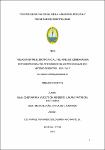| dc.contributor.advisor | Sologuren Anchante, Rafael Fernando | |
| dc.contributor.author | Chevarria Vucetich Moberg, Laura Patricia Katiuska | |
| dc.contributor.author | Maco Luján, Rosa Del Carmen | |
| dc.date.accessioned | 2017-01-09T14:45:00Z | |
| dc.date.available | 2017-01-09T14:45:00Z | |
| dc.date.issued | 2016 | |
| dc.identifier.uri | http://repositorio.unapiquitos.edu.pe/handle/20.500.12737/3435 | |
| dc.description.abstract | El propósito de la presente investigación fue determinar la relación entre el biotipo facial y el nivel de sobremordida en pacientes adultos atendidos en el centro de salud San Antonio de Iquitos, 2015. El tipo de investigación fue cuantitativa, el diseño fue no experimental, correlacional, transversal, la muestra estuvo conformada por 212 pacientes adultos (30 a 59 años); se utilizó fotografías extraorales frontales para medir el ángulo de convergencia y la medida de la sobremordida con regla milimetrada para obtener el nivel de sobremordida de cada paciente. Los resultados más importantes fueron: el mayor porcentaje de la muestra fue del biotipo facial dolicofacial (93.4%), seguido por el normofacial (6.6%), no se encontró en pacientes el biotipo braquifacial. El mayor porcentaje de la muestra presentó una sobremordida normal (50.5%), seguido por el bis a bis (42%), mordida profunda (6.6%) y por último mordida abierta (0.9%).La muestra tuvo un promedio de edad de 40.47+ 8.87 años. La muestra presentó un promedio de sobremordida de 1.58 + 1.7 mm. La muestra presentó un promedio de ángulo de la convergencia de 31.82 + 4.72 mm. El biotipo dolicofacial presentó en mayor porcentaje una sobremordida normal (47.6%), seguido de bis a bis (38.7%), mordida profunda (6.6%) y mordida abierta (0.5%). El biotipo normofacial presentó en mayor porcentaje una mordida bis a bis (3.3%), seguido de sobremordida normal (2.8%) y mordida abierta (80.5%). No existe relación entre el biotipo facial y el nivel de sobremordida (p=0.143). Ambos géneros presentaron sus mayores porcentajes de biotipo dolicofacial, seguido de normofacial. No existe relación entre el biotipo facial y género (p=0.345). El género masculino presentó su mayor porcentaje en sobremordida normal (5.7%), seguido de bis a bis (2.4%). El género femenino presentó su mayor porcentaje en sobremordida normal (48.8%), seguido de bis a bis (39.6%), mordida profunda (6.6%), y mordida abierta (0.9%). No existe relación entre el género y el nivel de sobremordida (p=0.420). | es_PE |
| dc.description.abstract | The purpose of this research was to determine the association between facial biotype and
the degree of vertical overbite in adult patients treated at the health center San Antonio of
Iquitos, 2015.
The research was quantitative, the design was not experimental, correlational, crosssectional,
the sample consisted of 212 adult patients (30-59 aged); extraoral frontal
photographs was used to measure the angle of convergence and vertical overbite was
measured using a millimetric rule. The most important results were: the highest
percentage of the sample was 93.4 per cent for dolichofacials, followed by a 6.6 per cent
for mesofacials, with no brachyfacial types found. The highest percentage of the sample
has a normal overbite (50.5 %), followed by a bis a bis bite (42%), deep bite (6.6%), and
finally open bite (0.9%). The sample had an average age of 40.47 + 8.87 years. The
sample showed an average of 1.58 + 1.7 mm overbite. The sample showed an average
convergence angle of 31.82 + 4.72 mm. Among dolichofacials, a normal overbite was
found to be predominant (47.6%),) followed by a bis a bis bite (38.7%), deep bite (6.6%),
and an open bite (0.5%). Among mesofacials, a bis a bis bite was found to be predominant
(3.3%) followed by normal overbite (2.8%) and open bite (80.5%).
Facial biotypes are not associated with the degree of vertical overbite. (p=0.143). both
genders presented their highest percentages of dolichofacial biotype, followed by
mesofacial biotype. Facial biotype are not associated with gender (p=0.345). Male gender
showed a highest normal overbite percent (5.7), followed by a bis a bis bite (2.4%).
Female gender showed a highest normal overbite percent (48.8%) followed by a bis a bis
bite (39.6%), deep bite (6.6%) and an open bite (0.9%). Overbite degree is not associated
with gender (p=0.420). | en_US |
| dc.description.uri | Tesis | es_PE |
| dc.format | application/pdf | es_PE |
| dc.language.iso | spa | es_PE |
| dc.publisher | Universidad Nacional de la Amazonía Peruana | es_PE |
| dc.rights | info:eu-repo/semantics/openAccess | es_PE |
| dc.rights | Attribution-NonCommercial-NoDerivs 3.0 United States | * |
| dc.rights.uri | http://creativecommons.org/licenses/by-nc-nd/3.0/us/ | * |
| dc.source | Universidad Nacional de la Amazonía Peruana | es_PE |
| dc.source | Repositorio Institucional - UNAP | es_PE |
| dc.subject | Biotipología | es_PE |
| dc.subject | Adultos | es_PE |
| dc.subject | Sobremordida | es_PE |
| dc.title | Relación entre el biotipo facial y el nivel de sobremordida en pacientes adultos atendidos en el Centro de Salud San Antonio de Iquitos – Perú, 2015 | es_PE |
| dc.type | info:eu-repo/semantics/bachelorThesis | es_PE |
| thesis.degree.discipline | Odontología | es_PE |
| thesis.degree.grantor | Universidad Nacional de la Amazonía Peruana. Facultad de Odontología | es_PE |
| thesis.degree.level | Título Profesional | es_PE |
| thesis.degree.name | Cirujano Dentista | es_PE |
| thesis.degree.program | Regular | es_PE |
| dc.subject.ocde | http://purl.org/pe-repo/ocde/ford#3.02.14 | es_PE |


